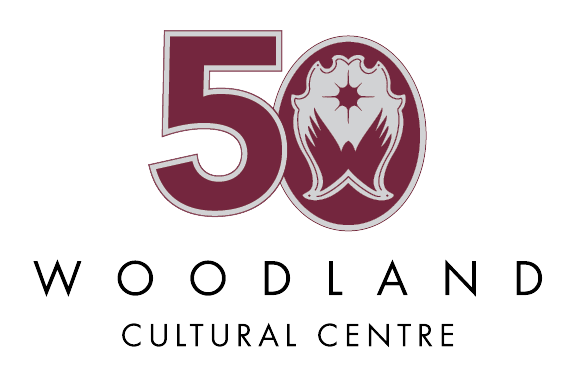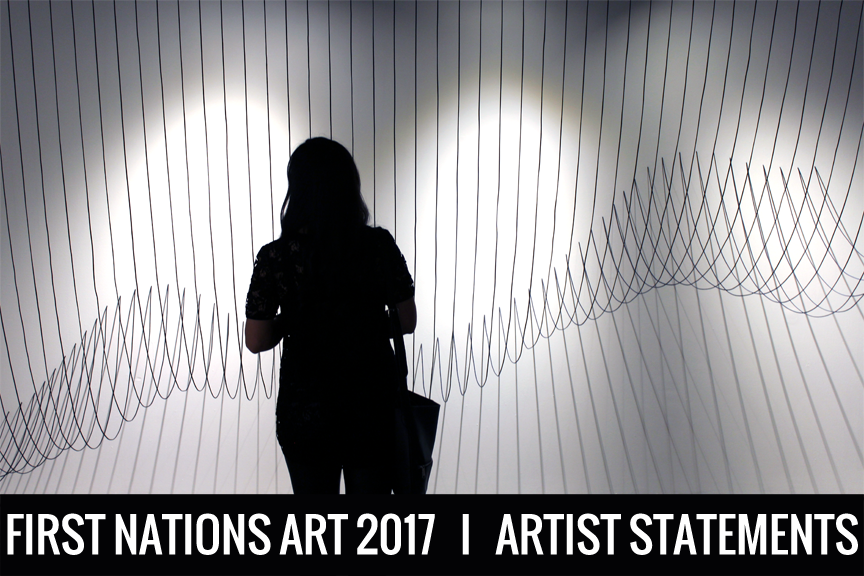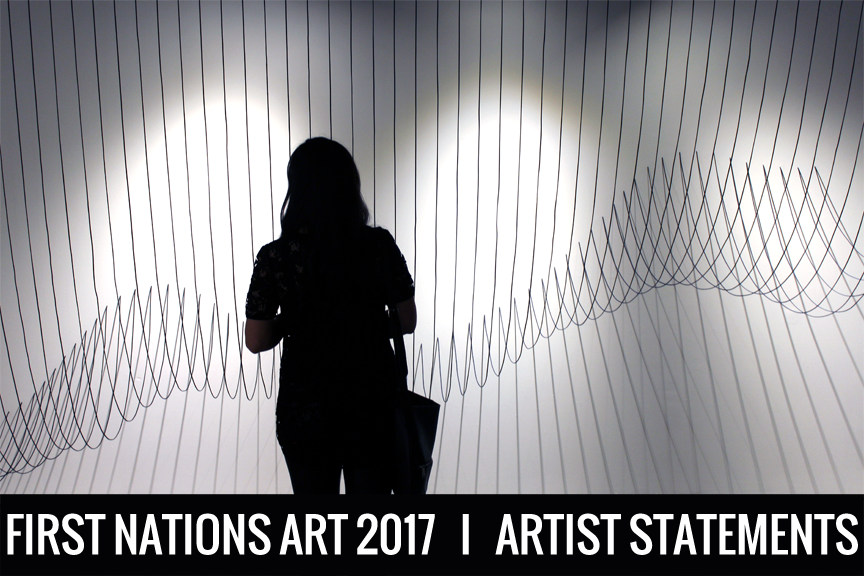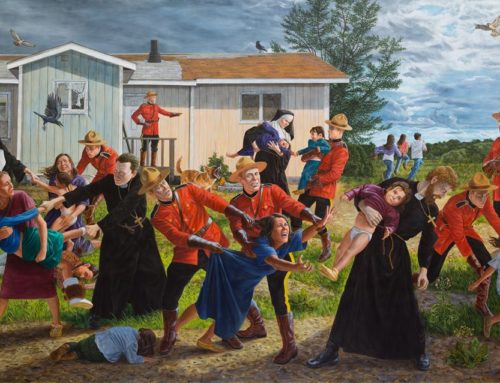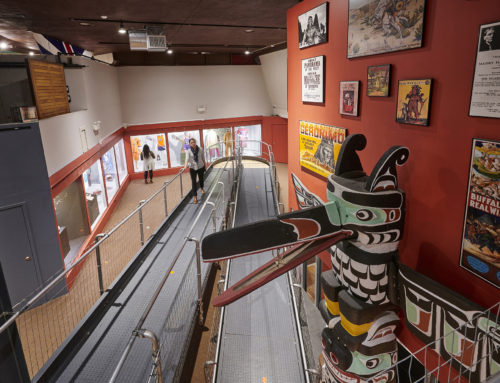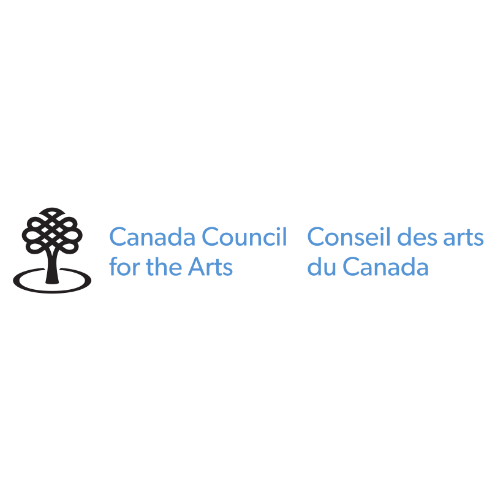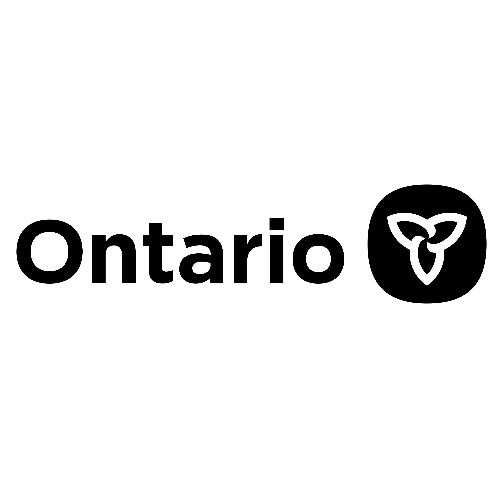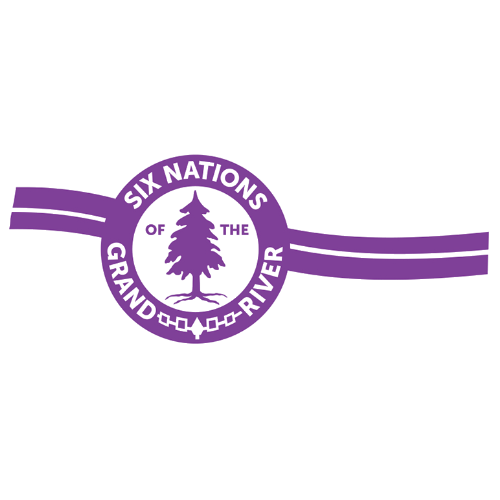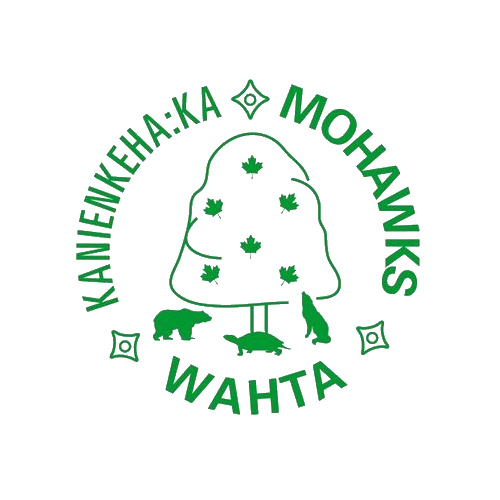Quinn Smallboy, Featured Artist
My current practice investigates Indigenous art and its relation within Western ideologies. Areas of interest I explore within Indigenous art is where does it fit into the contemporary field of art? My latest work explores common symbols of Indigenous cultures and traditions from the traditional hand drum of the powwow to intricate string work. My work in some case are large scale webbings of string, to small hand drum size. My work is also seen on an abstract level that explores a balance between lines and space. Shaping a space, I employ the use of the line represented by rope or string. The characteristics in which I use the material help me build a based or a platform in which I assemble multiple lines of conversion to animate a void.
Aura (Monique Bedard)
I am inspired by storytelling and the healing journey, individually and as a community. Currently, I combine painting, drawing, beadwork, image transfers, and collage to examine stories that are connected to the mind, body, and spirit. I aim to address the pain of intergenerational trauma and intergenerational healing to communicate experiences from inside out. By unearthing my own stories, this experience is ultimately part of the healing journey.
My newest series is titled, Alwelyá’ne | Kayá’tale (My Heart | Portraits). There are so many times people in our communities are misrepresented or seen in a negative light. It is my goal with this series is to create portraits of people in a good way. Chief Lady Bird said that I put “emphasis on individual truths, reclamation of our identity, sovereignty over our bodies and emotions, and the importance of love,” which is my intention. I also give people the option to share a story or quote that ultimately becomes the caption. Too often, other people decide what our stories are and I want my art to serve as a platform for people to reclaim their stories.
Website: www.auralast.wix.com/auralast
Michael Barber
My works deal with examination of dark realities that are rarely spoken. Memories and thoughts are never clear and my paintings reflect the layers that hide or protect our past, the things we cherish and the things we’d love to forget. Quite often in life, things that are out of our control have such impact on our lives, not physically really but emotionally, things that we will carry with us forever. The good and the bad both weigh us down and fill us up, to the point that there’s no room left. Then one day, something happens that forces you to shift things, reposition and prioritize the weight to a more manageable point for the time being.
I paint on mahogany plywood and use a mix media approach. Resist techniques are used with the paint application. Gouging and scratching is done with various hand tools, shovels and hoes are used to scrape the work and expose the earlier layers to create a sense of time. Images are applied to the work by using a very primitive printing technique and manipulating the cut after various applications.
The creation of a piece is a very physical activity. I get lost in the painting and struggle between layers, caught in a dilemma of exposure and protection. It’s an exhausting process and yet I find it so satisfying.
Taker
It was about 2 a.m. when I got the call that Gramma B wasn’t going to make it through the night and I should come to the hospital to say goodbye. When I walked into her room and stood beside her bed, she began speaking to me in a language I’d never heard before. I couldn’t understand a word she said, she was speaking through tears. When I left her room, the emptiness I felt was unimaginable. Gramma B survived the Mush Hole. She never spoke about her experience. I heard she was punished for speaking her language. The sculpture is called “taker.” The message across the face is written in Mohawk, it means “ I love you Gramma.”
Teyotsihstokwáthe Dakota Brant
May Their Journeys Be Gentle. By age nine tótah had run away from the Mohawk Institute three times. The first time was home to his mother, who put him in a car and sent him back. The second and third time he and two buddies hopped the train trying to get to Kahnawà:ke where one of them was from. His Kahnawà:ke friend had plans for them all to be taken care of and raised by his father if only they could get to Kahnawà:ke. Each time my tótah told me they got as far as Tyendinaga before they were caught and brought back. I can’t imagine a 9 year old today having the capacity to get as far as Tyendinaga by themselves twice, or what would compel them to, or what did it take for my tótah to lose such trust in his own mother that he never tried to go to her for help again. It wasn’t until late in life just before he passed that his reports of being molested in school for years were exonerated in the court system, backed up by the testimonials of other male residential school survivors who suffered at the hand of the same teacher who would die without ever spending a day in prison.
Our tótahs survived residential school in more ways than we can count. I think back at his 7, 8, 9 year old self in council with his little buddies, planning their next run. We hear reports today and face the reality that many of those babies who ran died along the way, just trying to get home. I am a new mother, and seeing my own baby, knowing we are alive today because my tótah survived, I understand more the anguish a parent had to go through, to be told that because of the race they were born into they have no legal responsibility, authority or right to maintain their own childrens’ safety, health and wellbeing.
In the end we all go home; but for some it is home to the arms of the Creator, not their mother. My piece is in honour of those babies who never made it home. It’s in honour of the broken relationship my tótah had with his mother for the rest of his life. The Haudenosaunee Creation story tells us that the path to the Skyworld is strewn with strawberries left by Skywoman as she fell from the hole in the sky to the Waterworld. In our Baby Naming Ceremony we are explained that each baby comes to this world with gifts and talents that we will have to good fortune to witness. The vamps I left empty, because I felt empty when I wondered what gifts and talents our world never got to witness. I call the piece “May Their Journeys Be Gentle” because gentle is how I describe the love my baby has brought me, and the love I believe we all deserve.
Janice Brant
Grand Flower
Grand Flower is an original acrylic painting on canvas, January 2017. The idea came from designing seed packets to share with other Mohawk and Haudenosaunee seed keepers. The packages were unique in that Mohawk language was used. I began to look at seed packages new and vintage. What information was included on the packages? What kind of art and images decorated them? I discovered that some vintage seeds packages and advertisements had images of Native people, most often the Chief in the War Bonnet. This painting shares similar characteristics with what might appear on a seed package or ad with a contemporary sentiment in which we are reclaiming our traditional food crop and calling them by their original names.
Jennifer E. Brant
On the Journey
The inspiration for this piece came from my two daughters. They each had made small versions of the Great Tree of Peace with coloured clay. One had made a white canoe and talked about the Peacemaker’s journey. While creating the art, I was thinking of the Peacemaker and his journey from our community here at Tyendinaga to the other nations of the Haudenosaunee.
Catherine Dallaire
My work blends elements and teachings from Woodland art/Anishinaabe art & culture and subject matter with contemporary realism techniques and subjects. Each piece aims to create synergy and harmony between these two different stylings as a visual effort to build and maintain a balanced and peaceful relationship between my Anishinaabe and European ancestry. Many of my pieces strive to call to attention the importance of our connection to everything in nature, and respect towards it and all our relatives, particularly animals, plants and insects that are overlooked or whose importance and teachings have been altered by colonial attitudes and viewpoints.
Deron Ahsén:nase Douglas
Deron Ahsén:nase Douglas works with oils on canvas (although he has dabbled in stone and wood carving, clay, photography, water color, acrylic and print-making) he creates unique fine art inspired by his Kanien’kehá:ka culture. This culture he states, “…is an abundant source of creative expression” that helps him to entwine traditional values with contemporary subject matter. Working with bold colors, a crisp design and a unique sense of humour, he creates what he calls “a culmination of pebbles picked up along the path”.
Amanda Marie Flynn
Instagram: @diamanda
Facebook: DiAmandaTattoo
Website: www.telltalehearttattoo.com
Lorrie Gallant
Art is our stories and our medicine. When we didn’t have a written language we had art to express ourselves. Our songs, our music, our dance and our art created a map for us to follow. As indigenous people we understand there is a tremendous responsibility when we create art. We are not just making it for ourselves, we are narrating our history, illuminating our story, and recording the journey of our souls. Our art is imbedded with instructions from our ancestors. It will help us to understand how the world came to be and guide us through the complexities of life. Art provides us with a story not yet finished. As a nation of people with roots deep into Mother Earth we must pick up the trail left by the ancient ones and the cycle continues as we leave a map for others to follow.
Yvonne Garbutt
Both design and content are equally important in my work. I enjoy exploring colour, texture and shape-constructing and building form with paint. Incorporating found objects- craft items may seem to support humour in the work, but it primarily honours the craftswomen in my family. The content often deals with family history, issues of identity, politics, and the environment. Language has always been another element that I have incorporated in my art. Text figures prominently. I am a student of Anishinaabemowin. There is often a narrative element evident. Indigenous culture is an oral tradition and in my art, I can relate and interpret the stories passed down to me by my grandmother.
Kelly Green
Tsityonnhe (We Are Still Alive) Canadian Flag Fancy Shawl
This fancy shawl’s Mohawk words written atop the Canadian Flag are to celebrate that “Our language and culture/traditions are still alive. We are still alive!”, despite all that was attempted by the government and church. I have a strong desire to one day learn this language of my Grandmother. The white and purple ribbons sewn at the top and bottom of the flag represent the Two-Row Wampum Belt that was taken to treaties to signify the courses of two vessels, a Haudenosaunee canoe and a European ship, traveling the river of life together, never to interfere with the affairs of the other. This has not yet been respected, as most land was taken and people removed by various tactics with little or no compensation. However, I look forward to when the treaties are honoured. As well, I’m hopeful a wonderful fancy dancer will one day bring this shawl to life, and the fringe will swirl and bounce to the music of the singers and drums.
Jay Havens
Jay is from Haudenosaunee-Mohawk and Scottish-Canadian ancestry and a proud member of the Six Nations of the Grand River, Mohawk Bear Clan. For the last 25 years he has lived on Coast-Salish and Haida territories specifically practising his craft in Sto:lo and Musqueam regions of Vancouver and the Fraser Valley. For the last 15 years I have worked as a freelance designer, artist in residence, and educator. As a multidisciplinary artist, Jay finds himself employed in the areas of contemporary art and curation, art based education with elementary-post secondary students, mural making and scenography (stage design and production). Jay has a Bachelor of Applied Art at Emily Carr University of Art + Design (‘16). Jays work attempts to questions tradition and contemporary Indigeneity through material investigations and process of making.
Instagram: jay.havens
Website: www.jayhavens.me
Barbara-Helen Hill
The Little Dipper
I had a collection of faces from Steve Smith and while wondering what to do with them I saw the faces as representing the stars of the Little Dipper. As in the other quilt “They Danced into the Night…” The Iroquois tell this story about the Little Dipper: There were once eight little Indian boys who were great friends. Every evening they came to a little mound to dance and feast. They would first eat their corn and beans, and then one of their number would sit upon the mound and sing, while the others danced around the mound. One time they thought they would have a much grander feast than usual, and each agreed upon what he would bring for it. But their parents would not give them what they wanted, and the little lads met at the mound without their feast. The singer took his place and began his song, while his companions started to dance. The singer told them to not look back. As they danced they forgot their sorrows and “their heads and hearts grew lighter,” until at last they flew up into the air. Their parents saw them as they rose, and cried out to them to return; but up and up they went until they were changed into the seven stars of the Little Dipper. The one little boy who looked back became the falling star.
The Bear and the Big Dipper
I had faces made by Steve Smith and envisioned them as part of the story of the Big Dipper.
Bear is being hunted by three warriors named after birds, Robin, Chickadee, and Cowbird, as represented by the stars of the handle of the Big Dipper. These three stars are sometimes referred to as ‘the hunters who are always hunting’. As Bear awakens from hibernation in the early spring, she leaves her Den in search of food and starts eating everything. The people are starving so the Hunters tell them they will kill the bear. They spot her fresh tracks in the snow and begin the pursuit. Bear is stalked by the Hunters throughout the spring and summer, slowly following her up thru the sky country and back down the other side. In late autumn, the Hunters finally catch up to Bear near the bottom of the sky country, close to the Earth. Bear rises up on her hind legs to fight the Hunters, but Robin takes careful aim and shoots her with an arrow and Bear falls over dead on her back. Blood from Bear’s wound sprinkles down on the forests of the land below and stains the leaves red. This is why tree’s leaves change color in the fall. Some of the blood stains Robin’s chest, and this is why these birds have red breast today. Bear’s spirit has already entered another Bear hibernating in her Den in Corona Borealis. In the spring, she re-awakens and leaves her den. Once again the hunt begins anew, repeating each year for all eternity.
Mary Jacobs
My beadwork has evolved over the years from simple daisy chains to raised beadwork collars and cuffs. I started learning from my grandmother as a teenager and has continued to learn new techniques from the elders in her community. I enjoy beading and take pleasure in watching her creations take shape. Most of my creations are wearable and reflect the world I live in. I bead flowers, vines, birds, animals, and simple smooth lines in most of her work. I work with glass, stone and seed beads applied to cloth or leather. My sewing skills complement my beadwork skills to create unique traditional outfits such as dresses, shirts, leggings, breech cloths, and skirts. My interest also include making beaded picture frames and other household items such as needle cases and pin cushions. The beading knowledge I have acquired, I continue to share with others. I have taught classes in local schools, elders community centers and for my local native language and culture program. I encourage my students and myself look around and take inspiration from the gifts the creator has made for us.
Samantha Jacobs
I make art as a way to reflect the world around me in a self-expressive visually appealing way. No matter what the subject of a piece deals with, whether it’s a random flower or leaf that caught my eye or a particularly interesting story I’ve heard along my travels, my completed work is always about telling a story. Often times that story may only mean something to me, but it still tells a story or holds a memory of an experience I want to keep, remember and share with those around me. I’m a part time artist. I work on my pieces because I find it relaxing and really that’s why I do what I do, whether that means I’m playing in my beads or making a mess with corn husk. In the end all that matter is that I’m happy with what I finish.
Keitha Keeshig-Tobias
Instagram: @keeshigtobias
Facebook: Biizindam
Website: www.biizindam.com
Clayton King
Clayton Samuel King is a multi-media artist that works predominantly with acrylic paint. When creating his work, he will apply different techniques that help expand his knowledge of artistic expression. The common themes in his work relate to his Indigenous cultural background that is highly influenced by the Professional Native Indian Artist Incorporated, 3 generations of Woodland School artists and the sublime of nature. He does his best to interpret the knowledge that has been bestowed upon him to help sustain Anishinaabek culture and history through several artistic practices. He has recently been working and experimenting with visible and invisible ultraviolet luminescent paint. Working in the dark is different, but the advantage of this new media has helped him heighten the spectral and metaphysical aesthetic he wants to produce to the viewer. This medium is new to the Woodland Art Style and it is a medium that Clayton will continue to use in the future.
Martin Akwiranoron Loft
My art is a reflection of who I am as an Indigenous person (Kanien’keha:ka). As an artist, I strive to incorporate the iconography, teachings, and themes as a source of inspiration for my artistic production in a modern setting. I believe each image is a spark of creativity revealed in a tangible form….an artifact representing my personal truth and journey. Whether I am working in the medium of photography, printmaking, silver-smithing, or digital arts, I strive to represent this aspect of myself through creativity, cultural reflection, and historical concerns.
Mark Neal
The more I paint the more I realize there’s nothing more artistic than to love one another.
I have always strived to be unique and true always trying to bring to life what’s in my heart. In many ways, the work of a artist is easy. We risk very little, yet enjoy a position over those who are not. We offer up our work and ourselves to your judgement and thrive on negative criticism. But bitter truth we artist’s must face is that in the grand scheme of things, the average piece of junk is probably more meaningful than your criticism designating it so. But there are times when I truly risk something and that is in the discovery and defense of the new. The world is often unkind to new talent, new creations. The new needs friends.
Facebook: mnexcel
Holly Pichette
Holly Pichette is a multi-disciplinary artist whose creative output includes mixed media sculptures and paintings, mural painting and beadwork art. Her artistic practice is inspired by the intrinsic, handmade beauty of traditional beadwork. Much of her work is highly detailed and labor intensive. She uses vibrant colors and mixed media to create her work, working with materials such as seed beads, hide, vinyl, acrylic paints, beeswax and canvas. Holly is also a jewelry designer who has her own unique line of contemporary beadwork. She recently graduated from the Fine Art Advanced Diploma program at Fanshawe College and before that she had been working as a self-taught artist for the past 15 years. She currently lives in London, ON with her young son Phoenix and continues to work as a professional visual artist. Pichette’s artwork has been collected and exhibited in numerous galleries in Canada and her most recent work has been shown in London ON at The Arts Project and Satellite Gallery.
Nelson White
I am a Mi’kmaq painter who is interested in depicting my culture; stories and dance traditions of my home community of Flat Bay, Newfoundland. My contemporary style includes cultural symbols that connect me to the spirit of Canada’s Aboriginal Community. My work is recognised through a fusion of design with figurative detail which emphasizes the rhythm, composition and overall aesthetic of my works. My work is a representational yet an interpretive depiction of real people, real places and objects I see every day. The use of the term ‘realism’ in characterizing contemporary representational art can be confusing, so I prefer the terms ‘representational’ or ‘objective,’ which indicate images based upon concrete referents, but leave open a wide range of subject matter and technical and stylistic treatments. My work is a mix of other influences from Andrew Wyeth to Edward Hopper to Alex Coville, figurative painters with a strong emphasis on composition. I am also interested in the work of indigenous painters including Norval Morrisseau and Alex Janvier. My creative approach is balance painting and illustration, seeking inspiration from a variety of artistic genres and periods. Regardless of the various techniques I use in my work, my art is based upon drawing. I am not interested creating photo realism, but colour and shape. Although this is clearly a figurative work, I try to flirt with abstraction; flatting the surface, using bright colours and black lines. I believe angst is all too often represented in modern art, and there should be room for bright fun work.
